 In the waning days of the Time War, the Doctor tires of the constant fighting and bloodshed. He breaks into the Time Lords’ Omega Archives, containing forbidden Gallifreyan superweapons (most of which have already been unsuccessfully deployed against the Daleks). He takes the Moment, a galaxy-devouring weapon of mass destruction which has never been used because its sentient operating system has developed its own conscience, and will stand in judgement over whoever might try to use it. The Doctor abandons his TARDIS and sets off on foot to a bombed-out structure in the wastelands of outer Gallifrey, fully intending to activate the Moment and end the war. He’s puzzled when a young woman appears suddenly and refuses to leave: this is the Moment’s conscience, ready to try to dissuade its operator. It has chosen the appearance and voice of one of the Doctor’s companions, but has gotten past and future mixed up. The Moment offers to show the Doctor what will happen to him after he destroys Gallifrey…
In the waning days of the Time War, the Doctor tires of the constant fighting and bloodshed. He breaks into the Time Lords’ Omega Archives, containing forbidden Gallifreyan superweapons (most of which have already been unsuccessfully deployed against the Daleks). He takes the Moment, a galaxy-devouring weapon of mass destruction which has never been used because its sentient operating system has developed its own conscience, and will stand in judgement over whoever might try to use it. The Doctor abandons his TARDIS and sets off on foot to a bombed-out structure in the wastelands of outer Gallifrey, fully intending to activate the Moment and end the war. He’s puzzled when a young woman appears suddenly and refuses to leave: this is the Moment’s conscience, ready to try to dissuade its operator. It has chosen the appearance and voice of one of the Doctor’s companions, but has gotten past and future mixed up. The Moment offers to show the Doctor what will happen to him after he destroys Gallifrey…
Clara, having taken a job at Coal Hill School, gets a message from the Doctor and sets out to find the TARDIS. Moments after the time travelers are reunited, the TARDIS lurches unexpectedly, thanks to the UNIT helicopter that has grappled it and is hauling it toward the center of London. With the TARDIS now relocated to the National Gallery, Kate Lethbridge-Stewart shows the Doctor why UNIT need his expertise: a number of paintings, exhibiting an unusual three-dimensional effect, have had their glass frames broken from within; all of the paintings also once had humanoid figures in them, but those figures are now missing. Before the Doctor can investigate, a time fissure appears in mid-air in the Gallery, and he leaps through it, finding himself face-to-face with his tenth incarnation, who is dealing with a shapeshifting Zygon attempting to impersonate Queen Elizabeth I. And moments later, both Doctors are stunned – and alarmed – when another of their incarnations emerges from the fissure: an older man who does not regard himself as the Doctor. This is the incarnation of the Doctor who fought in the Time War, ending it in a pyrrhic stalemate that wiped out both the Time Lords and the Daleks, the incarnation that the later Doctors refuse to acknowledge; the Doctor’s true ninth life. The Queen orders all three of them taken away to the Tower of London.
In the modern day, the Tower is now UNIT’s headquarters, and the home of the Black Archive, a top secret repository of captured alien technology that would rival Torchwood’s collection. Kate and Clara return to the Tower, but it’s not until she is trapped in the Archive that Clara realizes that Kate has already been kidnapped and replaced by a Zygon. Grabbing a portable time manipulator that UNIT once took off of the briefly-dead body of a man named Captain Jack Harkness, Clara makes her escape, travels back to the past and rescues the three Doctors as well. The Doctors manage to thwart the Zygon invasion, but then the Doctor from the Time War vanishes. The tenth and eleventh Doctors follow him back to Gallifrey’s past – a place and time that the TARDIS shouldn’t be able to visit – and offer to help him activate the Moment so he doesn’t have to bear the consequences alone.
But the Doctor’s later incarnations, having struggled with the remorse of this act for hundreds of years, take the unprecedented decision to change history: save Gallifrey while allowing the Daleks to be destroyed, without interrupting their own timeline. But to save the Time Lords, more Doctors will be required – perhaps even Doctors who have yet to exist – and Gallifrey will have to be forcibly relocated, possibly into a parallel universe, leading to the impression that it has been destroyed. And even the Doctors’ attempt to save their home planet may still lead to its destruction.
written by Steven Moffat
directed by Nick Hurran
music by Murray GoldCast: Matt Smith (The Doctor), David Tennant (The Doctor), Christopher Eccleston (The Doctor), John Hurt (The Doctor), Paul McGann (The Doctor), Sylvester McCoy (The Doctor), Colin Baker (The Doctor), Peter Davison (The Doctor), Tom Baker (The Doctor), Jon Pertwee (The Doctor), Patrick Troughton (The Doctor), William Hartnell (The Doctor), Jenna Coleman (Clara), Billie Piper (Rose), Tristan Beint (Tom), Jemma Redgrave (Kate Stewart), Ingrid Oliver (Osgood), Chris Finch (Time Lord Soldier), Peter de Jersey (Androgar), Ken Bones (The General), Philip Buck (Arcadia Father), Sophie Morgan-Price (Time Lord), Joanna Page (Elizabeth I), Orlando James (Lord Bentham), Jonjo O’Neill (McGillop), Tom Keller (Atkins), Aidan Cook (Zygon), Paul Kasey (Zygon), Nicholas Briggs (voices of the Daleks and Zygons), Barnaby Edwards (Dalek 1), Nicholas Pegg (Dalek 2), John Guilor (Voice Over Artist)
Notes: The War Council shouldn’t be surprised at all that the Doctor can access the Omega Archives; his seventh incarnation was shown to be in possession of Time Lord superweapons that had presumably been with him for quite some time (Remembrance Of The Daleks‘ Hand of Omega and the living metal validium from Silver Nemesis, both aired in 1988). The Moment, first mentioned in The End Of Time Part 2 (2010), most closely resembles validium, but the Nemesis statue carved from validium had no obvious sign of a conscience, but did show signs of sentience.
The Zygons, though a popular monster in Doctor Who fandom, have only been seen in one prior television adventure, the Tom Baker era four-parter Terror Of The Zygons
(1975), though they have reappeared in novels and numerous times in the eighth Doctor’s audio adventures, and even have their own action figure – not bad for a one-off villain.
This story seems to necessitate a reshuffling of the Doctor’s playlist: the incarnation commonly believed to be the ninth Doctor is actually the tenth, the tenth Doctor is actually the eleventh, and the current incarnation played by Matt Smith is actually the twelfth. This means that the incarnation to be portrayed by Peter Capaldi – glimpsed very briefly in the scene in which all of the Doctors rush to Gallifrey’s rescue – is the Doctor’s thirteenth and final life… unless, of course, the Doctor has somehow used up another regeneration somehow.
Asthmatic UNIT scientist Osgood may or may not be related to Sergeant Osgood, who served under Brigadier Lethbridge-Stewart in The Daemons (1971). UNIT’s Black Archive was
established in the Brigadier’s final televised appearance, in the Sarah Jane Adventures two-parter Enemy Of The Bane, though it was not in the Tower of London at that time, meaning that the Black Archive has either been moved, or has a decentralized series of locations. Voice artist John Guilor, who had already provided the voice of the first Doctor in bonus features for the DVD release of 1964’s Planet Of Giants, reprised that voice for the every-incarnation-of-the-Doctor climax.
Whether you consider his final appearance to have occurred in 1981’s Logopolis or the 1993 charity special Dimensions In Time, this episode marks Tom Baker’s first appearance in new footage in
televised Doctor Who in a very long time; the exact nature of his character is left extremely vague.
One day after its premiere unfolded simultaneously in 94 countries, The Day Of The Doctor and its production team were awarded the Guinness World Record for the most widely watched non-news, non-sports drama presentation in the history of the medium of television.
LogBook entry & review by Earl Green
Review: I have to admit, I was nervous as hell in the run-up to The Day Of The Doctor. The anniversary audio story The Light At The End raised the bar significantly, though I was convinced that it was giving us multi-classic-Doctor action that The Day Of The Doctor would surely never give us. As no secret was made of the 50th anniversary episode steeping itself in the lore of the 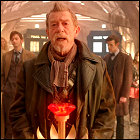 Time War, there probably wouldn’t be more than a handful of nods toward the classic series, right? And in any case, we’d just had The Enemy Of The World and The Web Of Fear returned to us, with persistent rumors of more missing episodes awaiting release. Short stories centered around each incarnation of the Doctor had been published monthly throughout the year, and audiobooks chronicling a sprawling adventure touching each of the Doctor’s lives had also been released on a monthly basis since January. This was all to ensure that the classic series fans’ anniversary jones was satisfied, right? Becuase surely the 50th anniversary episode on TV would be too busy talking Time War turkey to go there. Right?
Time War, there probably wouldn’t be more than a handful of nods toward the classic series, right? And in any case, we’d just had The Enemy Of The World and The Web Of Fear returned to us, with persistent rumors of more missing episodes awaiting release. Short stories centered around each incarnation of the Doctor had been published monthly throughout the year, and audiobooks chronicling a sprawling adventure touching each of the Doctor’s lives had also been released on a monthly basis since January. This was all to ensure that the classic series fans’ anniversary jones was satisfied, right? Becuase surely the 50th anniversary episode on TV would be too busy talking Time War turkey to go there. Right?
As it turns out, Day Of The Doctor not only twisted the timeline into pretzels that would leave Day Of The Daleks in the dust, but it gave us pie, baked into the center of a cake, with ice cream on top, whipped cream on top of that, and enough cherries to gag Pac-Man on top of that. Always wanted to see the climax of the Time War? Check. Wanted to hear more about the Moment to which vague references were made in The End Of Time? Check. Wanted to see Matt Smith 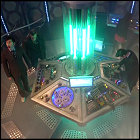 and David Tennant on the screen at the same time? You got it. Want to see all the other Doctors back in action, if only momentarily? Okay. Want to see the next Doctor in action, if only momentarily? Great, we just cast him, here’s a shot of his eyebrows looking fierce. Oh, wait, you never liked the whole Time War/survivor’s guilt angle and wish it never happened? Here you go! Gallifrey’s even back!…somewhere. Maybe. Click your heels three times to make sure.
and David Tennant on the screen at the same time? You got it. Want to see all the other Doctors back in action, if only momentarily? Okay. Want to see the next Doctor in action, if only momentarily? Great, we just cast him, here’s a shot of his eyebrows looking fierce. Oh, wait, you never liked the whole Time War/survivor’s guilt angle and wish it never happened? Here you go! Gallifrey’s even back!…somewhere. Maybe. Click your heels three times to make sure.
That’s quite a laundry list. And it could so easily have fallen apart. With the non-participation of Christopher Eccleston confirmed very early on, Steven Moffat took a huge roll of the dice on the notion of establishing another Doctor, one we hadn’t seen before, in the space of this episode. John Hurt, glimpsed briefly at the end of The Name Of The Doctor, would have to establish his incarnation’s personality, and be reprehensible and yet sympathetic and ultimately redeemable, in less time than The Five Doctors had to tell its entire story in 1983. Also, from a logistical standpoint, the production team had to produce an 87-minute special, in HD and 3-D, which stood a very good chance of becoming the most-rewatched episode of Doctor Who ever, with the same budget as a 45-minute-long 2-D weekly episode.
No pressure.
Honestly, one can spot where the wanna-be epic was hamstrung by its own budget. The Gallifreyan sets were dimly-lit spaces whose low lighting probably hid how little set there actually was. The War Doctor’s TARDIS cleverly makes use of the classic-style 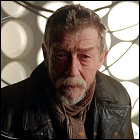 “roundel” TARDIS walls constructed for An Adventure In Space And Time‘s recreation of the Hartnell-era console room set, but this somehow makes the once-cathedralesque Eccleston/Tennant-era TARDIS set look much smaller. (It’s also easy to see that the original iteration of that set, mounted for scenes in the tenth Doctor’s TARDIS, no longer exists; it was dismantled long ago, and the show’s set designers simply had to hope that we’d be okay with the remaining set pieces that have been preserved for Cardiff’s Doctor Who Exhibition. The multi-level flooring and the long ramp from the exterior door were noticeably missing.) That all of this still managed to add up to something epic in scope is no small feat.
“roundel” TARDIS walls constructed for An Adventure In Space And Time‘s recreation of the Hartnell-era console room set, but this somehow makes the once-cathedralesque Eccleston/Tennant-era TARDIS set look much smaller. (It’s also easy to see that the original iteration of that set, mounted for scenes in the tenth Doctor’s TARDIS, no longer exists; it was dismantled long ago, and the show’s set designers simply had to hope that we’d be okay with the remaining set pieces that have been preserved for Cardiff’s Doctor Who Exhibition. The multi-level flooring and the long ramp from the exterior door were noticeably missing.) That all of this still managed to add up to something epic in scope is no small feat.
What was surprising was the sheer amount of humor involved, from the tenth Doctor serving a stern warning to the local fauna to the eleventh Doctor’s almost James Bond-esque trip to the National Gallery. Adding to the humor was a character I was almost certain, going in, that I’d dislike: John Hurt’s “War Doctor.” As much as this hitherto unknown Doctor was presold to us as the harbinger of death and doom on an unimaginable scale, he’s got a puckish sense of humor to compare with any of the other Doctors, and winds up routinely stealing the show, as well as copping to the excesses of Doctor Who in its present state, from the youth of the Doctor’s modern incarnations to the show’s current storytelling vocabulary. Whether it’s his ridicule of 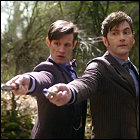 the phrase “timey-wimey” to continuously poking fun at how the tenth and eleventh Doctors brandish their sonic screwdrivers like weapons (“What are you going to do, assemble a cabinet at them?”), Hurt’s Doctor gleefully deconstructs everything Doctor Who has become since returning to TV. (And I have to say, I enjoyed this element of his character tremendously. It’s worth remembering that Steven Moffat’s first produced Doctor Who script was the 1999 all-star satire The Curse Of Fatal Death, which spoofed the excesses and tropes of the classic series gently but to great comedic effect.)
the phrase “timey-wimey” to continuously poking fun at how the tenth and eleventh Doctors brandish their sonic screwdrivers like weapons (“What are you going to do, assemble a cabinet at them?”), Hurt’s Doctor gleefully deconstructs everything Doctor Who has become since returning to TV. (And I have to say, I enjoyed this element of his character tremendously. It’s worth remembering that Steven Moffat’s first produced Doctor Who script was the 1999 all-star satire The Curse Of Fatal Death, which spoofed the excesses and tropes of the classic series gently but to great comedic effect.)
But far from being a dispensery of one-liners, Hurt also plays haunted and tortured well, and Day Of The Doctor would’ve been sunk if not for that ability. From the brief glimpse of a “reflection” of John Hurt from one of his earlier films at the end of Night Of The Doctor, we can deduce that this Doctor has been around longer than most. Where previously McCoy and McGann had been the standard bearers for visually aging in the role (thanks in no small part to the 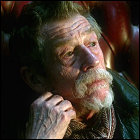 fact that their respective exit scenes were filmed years after their previous TV stints in the role), we see now a Doctor who has been aged by the circumstances in which he has found himself, and not in a silly “glue a Monty Python wig and beard onto Tom Baker” or “CGI Dobby Doctor” way, either. War is hell, and Hurt looks like he’s been through hell, probably from end to end several times over. He’s not enfeebled or “elderly”; he’s weathered and beaten, but still determined to do what he must. Hurt is magnificent in these scenes. My only beef with his character is that his last words – “Oh well, wearing a bit thin! I hope the ears are less prominent!” – are the very definition of an in-joke. If Hurt truly was the Doctor on the day it wasn’t possible to get it right, surely he should’ve had a more profound send-off. Maybe an echo of his earlier plea to make it worthwhile. Then again, with the burden lifted from his shoulders – at least until he regenerates and forgets the whole mess – I suppose levity is not entirely unfathomable (see also: the War Doctor’s childlike grin when joining his future incarnations in aiming his sonic screwdriver at the memory-wiping devices in UNIT HQ).
fact that their respective exit scenes were filmed years after their previous TV stints in the role), we see now a Doctor who has been aged by the circumstances in which he has found himself, and not in a silly “glue a Monty Python wig and beard onto Tom Baker” or “CGI Dobby Doctor” way, either. War is hell, and Hurt looks like he’s been through hell, probably from end to end several times over. He’s not enfeebled or “elderly”; he’s weathered and beaten, but still determined to do what he must. Hurt is magnificent in these scenes. My only beef with his character is that his last words – “Oh well, wearing a bit thin! I hope the ears are less prominent!” – are the very definition of an in-joke. If Hurt truly was the Doctor on the day it wasn’t possible to get it right, surely he should’ve had a more profound send-off. Maybe an echo of his earlier plea to make it worthwhile. Then again, with the burden lifted from his shoulders – at least until he regenerates and forgets the whole mess – I suppose levity is not entirely unfathomable (see also: the War Doctor’s childlike grin when joining his future incarnations in aiming his sonic screwdriver at the memory-wiping devices in UNIT HQ).
Speaking of the ears, though, I took great delight in Day Of The Doctor‘s willingness to put Christopher Eccleston into the 50th anniversary, whether he signed up for it or not. Hurt’s regeneration is an effects-slathered morph into a still photo of 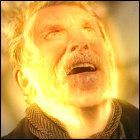 Eccleston, and while that runs the risk of being about as lame as the sixth Doctor’s regeneration into the seventh (with both incarnations played by Sylvester McCoy, going from wearing a curly blonde wig to not wearing one because Colin Baker had been unceremoniously removed from the role), it manages to work here. Eccleston even gets a line of dialogue in (though it’s lifted from one of his earlier episodes). Tom Baker should have given him a call and warned him: the Doctor isn’t a role you ever fully leave behind.
Eccleston, and while that runs the risk of being about as lame as the sixth Doctor’s regeneration into the seventh (with both incarnations played by Sylvester McCoy, going from wearing a curly blonde wig to not wearing one because Colin Baker had been unceremoniously removed from the role), it manages to work here. Eccleston even gets a line of dialogue in (though it’s lifted from one of his earlier episodes). Tom Baker should have given him a call and warned him: the Doctor isn’t a role you ever fully leave behind.
Eccleston’s co-star, Billie Piper, is one of Day Of The Doctor‘s best assets, playing not Rose, and not even Bad-Wolf-Rose, but being the mouthpiece of the mysterious superweapon known as the Moment. With a mode of dress not a million miles away from Idris (The Doctor’s Wife), this visual iteration of Rose is spooky and dangerous, yet playful and not just a little bit sexy. (This may well be your author’s favorite Doctor Who  performance by Ms. Piper, in fact.) The Moment is a weapon that doesn’t want to be used. And it’s important to note that, by the end of the episode, we don’t really know where it’s gone… unless it has been hauled back into the TARDIS, to be redeployed the next time it can provide strong story fodder (and the next time Billie has some free time in her schedule). The interplay between Piper and John Hurt is edgy and enjoyable, and there’s something interesting in the notion that Gallifreyan technology manifests as female (particularly in light of the New Adventures novels’ backstory, which included a literal battle of the sexes on pre-time-travel Gallifrey, resulting in the female population departing Gallifrey for pastures new as the future sisterhood of Karn).
performance by Ms. Piper, in fact.) The Moment is a weapon that doesn’t want to be used. And it’s important to note that, by the end of the episode, we don’t really know where it’s gone… unless it has been hauled back into the TARDIS, to be redeployed the next time it can provide strong story fodder (and the next time Billie has some free time in her schedule). The interplay between Piper and John Hurt is edgy and enjoyable, and there’s something interesting in the notion that Gallifreyan technology manifests as female (particularly in light of the New Adventures novels’ backstory, which included a literal battle of the sexes on pre-time-travel Gallifrey, resulting in the female population departing Gallifrey for pastures new as the future sisterhood of Karn).
And as for the return of Gallifrey and the notion that finding and restoring it will become a new mission for the Doctor in the future? It’s an interesting concept, but runs the risk of becoming a knife’s edge for the show to straddle. One of Doctor Who’s 1970s BBC sci-fi stablemates, Blake’s 7, toyed with a similar story arc, a fruitless search for the character of Blake once he went missing at the series’ midpoint. The problem with subsequent episodes of Blake’s 7, particularly in the third season, was that they were either tied down to looking for Blake (in all the wrong places, naturally, leading to any number of misadventures), or the show’s remaining characters went about their usual business, seeming curiously unconcerned with Blake’s fate. “Looking for Gallifrey” could become the same double-edged blade. I’ll also admit to being a little bit torn at the idea that, thanks to the vagaries of time travel, the John Hurt incarnation forgets what has happened before he becomes the embittered, traumatized Christopher Eccleston Doctor, who in turn passes his guilt on to Tennant’s incarnation. Given how much the Doctor’s survivors’ guilt has informed his actions in what we previously knew as his ninth and tenth lives, and to some extent his eleventh, turning the end-result of the Time War into a 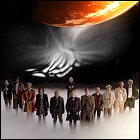 fake-out that leaves previous episodes intact almost seems like one showrunner deciding that another showrunner’s ideas need to be purged from the show. Moffat’s clever enough that he allows both to happen – the Doctor is plagued by the destruction of Gallifrey, and yet Gallifrey hasn’t been destroyed – and I’ll give him a pass on this one. That being said, when his own previous multi-Doctor mini-extravaganza, Time Crash, featured the tenth Doctor suddenly saving the day because his fifth incarnation remembered what he was about to do, it’s clear that the rules of one Time Lord’s incarnation remembering meeting another of his selves and either remembering or forgetting it are as follows: “his younger self remembers or forgets events based on what the story needs to happen.”
fake-out that leaves previous episodes intact almost seems like one showrunner deciding that another showrunner’s ideas need to be purged from the show. Moffat’s clever enough that he allows both to happen – the Doctor is plagued by the destruction of Gallifrey, and yet Gallifrey hasn’t been destroyed – and I’ll give him a pass on this one. That being said, when his own previous multi-Doctor mini-extravaganza, Time Crash, featured the tenth Doctor suddenly saving the day because his fifth incarnation remembered what he was about to do, it’s clear that the rules of one Time Lord’s incarnation remembering meeting another of his selves and either remembering or forgetting it are as follows: “his younger self remembers or forgets events based on what the story needs to happen.”
Which brings us to the last Doctor we meet in the story: the unexpected (but spoiled by the internet mere hours before the special’s premiere – thanks, internet) return of Tom Baker, as if he’s apologizing for having missed The Five Doctors. Obviously not the fourth Doctor, but hinting at possibly being a future Doctor, “the Curator” drops the plot development in the Doctor’s lap that Gallifrey is out there, somewhere – like the one-armed man, a shining beacon called Earth, the way off the island, a wormhole back to the Alpha Quadrant, or the leap home. It’s a lovely cameo that, unlike his recent audio 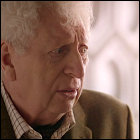 escapades, doesn’t require Tom Baker to be the Doctor as we know him – it only requires him to be Tom Baker, and it only requires him to pass the torch to Matt Smith, for the benefit of those who didn’t consider the torch passed between old series and new at any previous point in the new show’s history. Given that Baker turned 80 shortly after Day Of The Doctor‘s premiere, making him the oldest actor to have played the Doctor on television (beating even John Hurt by a few years), it’s more than a little bit haunting. The implication that the Curator is a future Doctor who has chosen to “revisit an old favorite [face]” is another passing of the torch: Doctor Who now passes into mythology. The Doctor, at some point in the future, wears whatever face you might be imagining he could wear. And as the following story, The Time Of The Doctor, proves in moving the end-of-life goalpost for the Doctor, it doesn’t matter how many lives someone says the Doctor has: he’s eternal and not beholden to these limitations. It simply doesn’t matter anymore. Relax, kick back, and enjoy the story. (And ponder the possibility that perhaps the Curator bestowed his beloved old scarf upon inhaler-carrying UNIT scientist Osgood. Maybe she’s his companion. Maybe Kate Stewart knows he’s there, knows who he is, and is sworn to keep his secret from his younger selves, because maybe he’s UNIT’s scientific advisor again. The Doctor’s story expands into infinity and also circles around to play some greatest hits.)
escapades, doesn’t require Tom Baker to be the Doctor as we know him – it only requires him to be Tom Baker, and it only requires him to pass the torch to Matt Smith, for the benefit of those who didn’t consider the torch passed between old series and new at any previous point in the new show’s history. Given that Baker turned 80 shortly after Day Of The Doctor‘s premiere, making him the oldest actor to have played the Doctor on television (beating even John Hurt by a few years), it’s more than a little bit haunting. The implication that the Curator is a future Doctor who has chosen to “revisit an old favorite [face]” is another passing of the torch: Doctor Who now passes into mythology. The Doctor, at some point in the future, wears whatever face you might be imagining he could wear. And as the following story, The Time Of The Doctor, proves in moving the end-of-life goalpost for the Doctor, it doesn’t matter how many lives someone says the Doctor has: he’s eternal and not beholden to these limitations. It simply doesn’t matter anymore. Relax, kick back, and enjoy the story. (And ponder the possibility that perhaps the Curator bestowed his beloved old scarf upon inhaler-carrying UNIT scientist Osgood. Maybe she’s his companion. Maybe Kate Stewart knows he’s there, knows who he is, and is sworn to keep his secret from his younger selves, because maybe he’s UNIT’s scientific advisor again. The Doctor’s story expands into infinity and also circles around to play some greatest hits.)
With the weight of history bearing down on him, Steven Moffat did okay here. Whether it’s a model of airtight plotting or not, The Five Doctors may well be the most-rewatched Doctor Who episode ever until now, and it’s not for nothing that it was the first story issued on DVD; there’s no reason to expect that The Day Of The Doctor will come in for any less scrutiny. The holes one could poke into its plotting are the same holes one could poke into any Doctor Who story before or after it. At this point, you’re either accepting of the 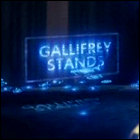 elasticity of Doctor Who’s plot logic, or you’ve given up and have moved on to watching something else. The Day Of The Doctor expands the series’ mythology significantly, boasts fun and memorable performances, and hits most of the crowd-pleasing notes that, frankly, I didn’t expect it to bother with. In short, this will become the new go-to episode people pull off the DVD shelf when trying to show their friends just how cool Doctor Who is. Moffat knew that and, though I haven’t always been happy with his handling of the show in the past, he delivered the goods. And you can’t expect or demand much more from the anniversary epiosde than that.
elasticity of Doctor Who’s plot logic, or you’ve given up and have moved on to watching something else. The Day Of The Doctor expands the series’ mythology significantly, boasts fun and memorable performances, and hits most of the crowd-pleasing notes that, frankly, I didn’t expect it to bother with. In short, this will become the new go-to episode people pull off the DVD shelf when trying to show their friends just how cool Doctor Who is. Moffat knew that and, though I haven’t always been happy with his handling of the show in the past, he delivered the goods. And you can’t expect or demand much more from the anniversary epiosde than that.
